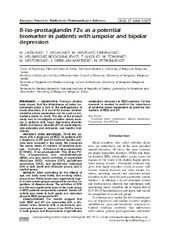Приказ основних података о документу
8-Iso-prostaglandin F2α as a potential biomarker in patients with unipolar and bipolar depression
| dc.creator | Lačković, Maja | |
| dc.creator | Stojković, Tihomir | |
| dc.creator | Pantović Stefanović, Maja | |
| dc.creator | Velimirović Bogosavljević, Milica | |
| dc.creator | Nikolić, Tatjana | |
| dc.creator | Tomanić, Milena | |
| dc.creator | Nestorović, Milica | |
| dc.creator | Debeljak-Martačić, Jasmina | |
| dc.creator | Petronijević, Nataša | |
| dc.date.accessioned | 2023-12-17T21:58:43Z | |
| dc.date.available | 2023-12-17T21:58:43Z | |
| dc.date.issued | 2023 | |
| dc.identifier.issn | 2284-0729 | |
| dc.identifier.uri | http://rimi.imi.bg.ac.rs/handle/123456789/1388 | |
| dc.description.abstract | Objective: Previous studies have shown that the disturbance of redox homeostasis plays a role in the pathogenesis of mood disorders. It is currently unclear whether oxidative stress parameters can be used as biomarkers (state vs. trait). The aim of the present study was to investigate oxidative stress markers in patients with major depressive disorder (MDD) and bipolar disorder (BP) in acute depressive episodes and remission, and healthy individuals. Patients and methods: Thirty-two patients with a diagnosis of MDD, 32 patients with a diagnosis of BP and 32 matched healthy controls were included in the study. We measured the serum levels of markers of oxidative damage, including 8-hydroxy-2'-deoxyguanosine (8-OHdG), 8-Iso-prostaglandin F2α (8-iso-PGF2α; 8-isoprostane), and malondialdehyde (MDA), and also serum activities of superoxide dismutase (SOD), catalase (CAT), glutathione peroxidase (GPX), and glutathione reductase (GR) in both acute and remission phase, and in control group. Results: After controlling for the effects of age, sex, body mass index, and smoking status, serum 8-iso-PGF2α levels were significantly higher in both patient groups compared to controls, regardless of disease phase. The activities of GPX and GR were significantly lower in the acute phase in MDD patients compared to controls. Serum GR activity was lower in both acute and remission phase in MDD compared to BP. Conclusions: Our results suggest that both MDD and BP are associated with a disturbed redox balance with a particularly pronounced increase in serum 8-iso-PGF2α levels in both groups and the presence of glutathione metabolism disorders in MDD patients. Further research is needed to confirm the importance of oxidative stress parameters as potential biomarkers of MDD and BP. | |
| dc.language | eng | |
| dc.publisher | Verduci Editore srl | |
| dc.relation | info:eu-repo/grantAgreement/MESTD/Basic Research (BR or ON)/175058/RS// | |
| dc.relation | info:eu-repo/grantAgreement/MESTD/inst-2020/200015/RS// | |
| dc.rights | openAccess | |
| dc.rights.uri | https://creativecommons.org/licenses/by-nc-nd/4.0/ | |
| dc.source | European Review for Medical and Pharmacological Sciences | |
| dc.subject | Oxidative Stress | |
| dc.subject | Depression | |
| dc.subject | Bipolar depression | |
| dc.subject | Glutathione | |
| dc.subject | 8-Iso-PGF2α | |
| dc.title | 8-Iso-prostaglandin F2α as a potential biomarker in patients with unipolar and bipolar depression | |
| dc.type | article | en |
| dc.rights.license | BY-NC-ND | |
| dc.citation.epage | 11507 | |
| dc.citation.epage | 11507 | |
| dc.citation.issue | 23 | |
| dc.citation.spage | 11496 | |
| dc.citation.spage | 11496 | |
| dc.citation.volume | 27 | |
| dc.identifier.doi | 10.26355/eurrev_202312_34588 | |
| dc.identifier.fulltext | http://rimi.imi.bg.ac.rs/bitstream/id/3225/bitstream_3225.pdf | |
| dc.type.version | publishedVersion |

